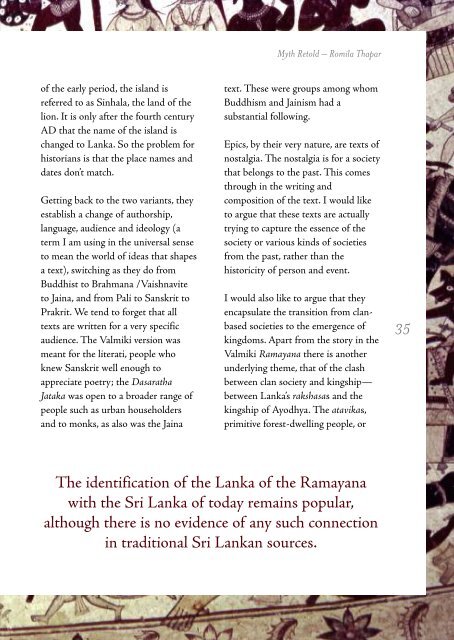Layout 3 - India Foundation for the Arts - IFA
Layout 3 - India Foundation for the Arts - IFA
Layout 3 - India Foundation for the Arts - IFA
You also want an ePaper? Increase the reach of your titles
YUMPU automatically turns print PDFs into web optimized ePapers that Google loves.
of <strong>the</strong> early period, <strong>the</strong> island is<br />
referred to as Sinhala, <strong>the</strong> land of <strong>the</strong><br />
lion. It is only after <strong>the</strong> fourth century<br />
AD that <strong>the</strong> name of <strong>the</strong> island is<br />
changed to Lanka. So <strong>the</strong> problem <strong>for</strong><br />
historians is that <strong>the</strong> place names and<br />
dates don’t match.<br />
Getting back to <strong>the</strong> two variants, <strong>the</strong>y<br />
establish a change of authorship,<br />
language, audience and ideology (a<br />
term I am using in <strong>the</strong> universal sense<br />
to mean <strong>the</strong> world of ideas that shapes<br />
a text), switching as <strong>the</strong>y do from<br />
Buddhist to Brahmana /Vaishnavite<br />
to Jaina, and from Pali to Sanskrit to<br />
Prakrit. We tend to <strong>for</strong>get that all<br />
texts are written <strong>for</strong> a very specific<br />
audience. The Valmiki version was<br />
meant <strong>for</strong> <strong>the</strong> literati, people who<br />
knew Sanskrit well enough to<br />
appreciate poetry; <strong>the</strong> Dasaratha<br />
Jataka was open to a broader range of<br />
people such as urban householders<br />
and to monks, as also was <strong>the</strong> Jaina<br />
Myth Retold – Romila Thapar<br />
text. These were groups among whom<br />
Buddhism and Jainism had a<br />
substantial following.<br />
Epics, by <strong>the</strong>ir very nature, are texts of<br />
nostalgia. The nostalgia is <strong>for</strong> a society<br />
that belongs to <strong>the</strong> past. This comes<br />
through in <strong>the</strong> writing and<br />
composition of <strong>the</strong> text. I would like<br />
to argue that <strong>the</strong>se texts are actually<br />
trying to capture <strong>the</strong> essence of <strong>the</strong><br />
society or various kinds of societies<br />
from <strong>the</strong> past, ra<strong>the</strong>r than <strong>the</strong><br />
historicity of person and event.<br />
I would also like to argue that <strong>the</strong>y<br />
encapsulate <strong>the</strong> transition from clanbased<br />
societies to <strong>the</strong> emergence of<br />
kingdoms. Apart from <strong>the</strong> story in <strong>the</strong><br />
Valmiki Ramayana <strong>the</strong>re is ano<strong>the</strong>r<br />
underlying <strong>the</strong>me, that of <strong>the</strong> clash<br />
between clan society and kingship—<br />
between Lanka’s rakshasas and <strong>the</strong><br />
kingship of Ayodhya. The atavikas,<br />
primitive <strong>for</strong>est-dwelling people, or<br />
The identification of <strong>the</strong> Lanka of <strong>the</strong> Ramayana<br />
with <strong>the</strong> Sri Lanka of today remains popular,<br />
although <strong>the</strong>re is no evidence of any such connection<br />
in traditional Sri Lankan sources.<br />
35


